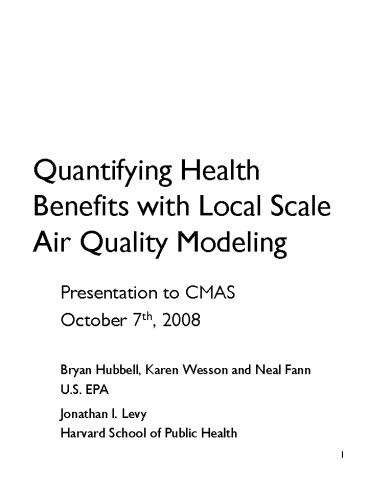Quantifying Health Benefits with Local Scale Air Quality Modeling - PowerPoint PPT Presentation
1 / 13
Title:
Quantifying Health Benefits with Local Scale Air Quality Modeling
Description:
Bryan Hubbell, Karen Wesson and Neal Fann. U.S. EPA. Jonathan I. Levy ... Matching the health data with the scale of the air quality data ... – PowerPoint PPT presentation
Number of Views:50
Avg rating:3.0/5.0
Title: Quantifying Health Benefits with Local Scale Air Quality Modeling
1
Quantifying Health Benefits with Local Scale Air
Quality Modeling
- Presentation to CMAS
- October 7th, 2008
- Bryan Hubbell, Karen Wesson and Neal Fann
- U.S. EPA
- Jonathan I. Levy
- Harvard School of Public Health
2
Overview
- Summarize how we estimate human health benefits
with local air quality modeling data - The basic steps in an Environmental Benefits
Mapping and Analysis Program (BenMAP) benefits
analysis - Matching the health data with the scale of the
air quality data - Understand how local-scale benefits are
influenced by - Resolution of exposure estimates
- Scale of baseline incidence rates
- Geographic specificity of health impact functions
- Discuss directions for future research
3
Step One Derive Health Impact Functions from
Epidemiology Literature
Epidemiology Study
Ln(y) Ln(B) ß(PM)
Health impact function
4
Step Two Apply the Health Impact Function to
Estimate Benefits
5
National-Scale Modeling Calls for Coarse-Scale
Health Inputs
Coarse-scale air quality modeling
Coarse-scale population exposure
Regional or national-scale Baseline incidence
and ß estimate
Regional or national Incidence count
6
Local-Scale Modeling Calls for Location-Specific
Health Inputs
Fine-scale air quality modeling
Fine-scale population exposure
Regional or national-scale Baseline incidence
and ß estimate
Local Incidence count
7
Comparing Population-Weighted Air Quality Changes
at 12km and 1km
Air quality change Population at 12km
Air quality change Population at 1km
8
Exposure Estimates Sensitive to Air Quality
Modeling Scale
- PM2.5 Population-weighted air quality change
highly variable - 12km -0.037 µg/m3
- 1km -0.715 µg/m3
- Summary conclusions
- 12km and 1km population exposure different
- Population exposure affected by proximity of
population centers to changes in grid-level air
quality
9
Assessing the Importance of Baseline Incidence
Rate Scale
- We calculate health impacts relative to some
baseline rate - Local analysis calls for local incidence rates
- Michigan DEQ provided ZIP-level rates for
- Respiratory hospitalizations
- Asthma
- Chronic Lung Disease
- Pneumonia
- Non-fatal heart attacks
- Acute Bronchitis
- Chronic Bronchitis
10
Chronic Bronchitis Rate Varies by Age and
Location in Detroit
11
The Level and Distribution of Avoided Chronic
Bronchitis Cases is Sensitive to the Incidence
Rate
Change in chronic bronchitis using national
incidence rate
Change in chronic bronchitis using Detroit
incidence rate
12
O3 Benefits are Sensitive to the Scale of the
Health Impact Function
Original Bell et al. (2004) mortality estimate
Detroit-specific Bell et al. (2004) mortality
estimate
13
Local Health Impact Analyses are Data-Intensive
- How best can we use local-scale air quality
modeling when we lack local - Health impact functions?
- Incidence rates?
- Do you use local concentration-response functions
when - They exhibit poor statistical power due to small
population sizes? - Are sometimes negative?
- They lack statistical significance?
- At what scale do you violate the fundamental
assumptions of epidemiology study?































